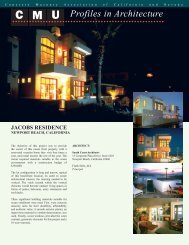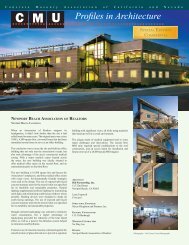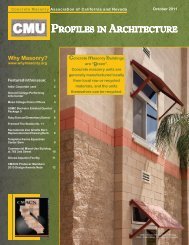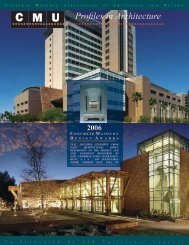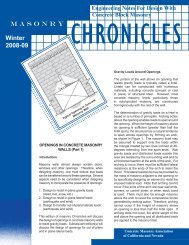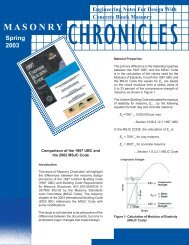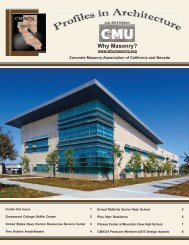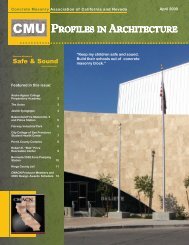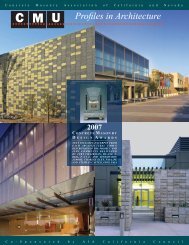Masonry_Chronicles_S.. - Concrete Masonry Association of ...
Masonry_Chronicles_S.. - Concrete Masonry Association of ...
Masonry_Chronicles_S.. - Concrete Masonry Association of ...
Create successful ePaper yourself
Turn your PDF publications into a flip-book with our unique Google optimized e-Paper software.
Figure 1 – Deflection <strong>of</strong> Wall with Openings<br />
The deflection components are calculated using the<br />
basic strength <strong>of</strong> materials equations for fixed-fixed<br />
piers and fixed-free piers, depending on the boundary<br />
conditions, as shown in Figure 2. The deflections <strong>of</strong><br />
the solid strip and pier are typically obtained assuming<br />
a fixed-fixed condition, since there is usually sufficient<br />
amount <strong>of</strong> wall above the openings to restrain rotation<br />
at the top <strong>of</strong> the piers.<br />
deformation and the second term is the shear<br />
deformation. The bending term considers the wall as<br />
a simple vertical cantilever beam with a moment <strong>of</strong><br />
inertia, I, which includes returns or pilasters at the<br />
ends <strong>of</strong> the wall. The cross-sectional area, A, is the<br />
area <strong>of</strong> the web and omits the flange areas. E m and E v<br />
are the Young’s modulus and shear modulus,<br />
respectively, which are given in Section 1.8.2.2 <strong>of</strong> ACI<br />
530-05/ASCE 5-05/TMS402-05 [1], also referred to as<br />
the 2005 <strong>Masonry</strong> Standards Joint Committee Building<br />
Code (MSJC), as:<br />
E = 900 f '<br />
(4)<br />
m<br />
m<br />
E = 0.4E (5)<br />
v<br />
m<br />
where f’ m is the masonry compressive strength.<br />
Assuming a unit lateral load that causes a deflection <strong>of</strong><br />
Δ is applied, Equations (3) and (5) can be used to<br />
obtain:<br />
3<br />
⎛H<br />
⎞ ⎛3H<br />
⎞<br />
Em<br />
Δ= ⎜ ⎟+<br />
⎜ ⎟<br />
(6)<br />
⎝ 3I<br />
⎠ ⎝ A ⎠<br />
Figure 2 – Deformation <strong>of</strong> Walls and Piers<br />
For fixed-free wall segments, the deflection is equal to:<br />
3<br />
VH 1.2VH<br />
Δ= +<br />
3E I AE<br />
m<br />
v<br />
where H is the height <strong>of</strong> the wall or pier and L is the<br />
length. The first term represents bending or flexural<br />
(3)<br />
For walls with rectangular cross-sections (no flanges)<br />
the cross-sectional area and moment <strong>of</strong> inertia are<br />
equal to:<br />
A = tL (7)<br />
3<br />
I = tL<br />
(8)<br />
12



